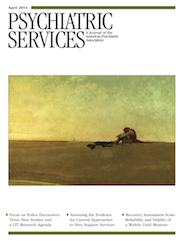Suicide Risk Assessment and Risk of Suicide in Schizophrenia
To the Editor: In the February issue, Pedersen and associates (1) reported that between 2005 and 2009, a steadily increasing proportion of patients with schizophrenia had received a suicide risk assessment at the point of discharge from Danish psychiatric hospitals. The authors also reported that 64 of 7,107 (.9%) discharged patients with schizophrenia died as a result of suicide during the following year. This second statistic suggests that patients with schizophrenia are approximately 80 times more likely to die by suicide than the general Danish population, for which the suicide rate is approximately 11.6 suicides per 100,000 per year (2). An understanding of the potential utility of risk assessment and the difference between absolute and relative risk suggests that the steady increase in risk assessment reported in Denmark represents the outcome of misguided policy.
A recent meta-analysis found that the odds of suicide among high-risk patients in the year after discharge from psychiatric hospitals were four times higher than among low-risk patients (3). This figure is dwarfed by the 80-fold increase, compared with the general population, in the likelihood of suicide among patients who are discharged with a diagnosis of schizophrenia. Irrespective of the patient’s risk category, any patient discharged with schizophrenia is many times more likely than an individual in the general population to die by suicide. The low specificity of risk assessment means that few of the patients classified as high risk will actually die by suicide. Patients classified as low risk will still be at many times the risk of suicide as the general population.
Unless there is an intervention to reduce suicide that is suitable for “high-risk” patients that should not also be available to “low-risk” patients there is no point in further stratifying the population of patients discharged with schizophrenia by their assessed relative risk. There is no such intervention. Risk assessment of patients discharged with schizophrenia is pointless. All discharged patients should be offered individualized, optimized care to improve well-being and thereby reduce the likelihood of their taking their own lives.
1 : Systematic suicide risk assessment for patients with schizophrenia: a national population-based study. Psychiatric Services 65:226–231, 2014Link, Google Scholar
2 Suicide rates (per 100,000), by gender, Denmark, 1950–2006. Geneva, World Health Organization, 2005. Available at www.who.int/mental_health/media/denm.pdf?ua=1Google Scholar
3 : Risk factors for suicide within a year of discharge from psychiatric hospital: a systematic meta-analysis. Australian and New Zealand Journal of Psychiatry 45:619–628, 2011Crossref, Medline, Google Scholar



